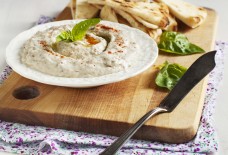Salads We Enjoyed on Our Farm
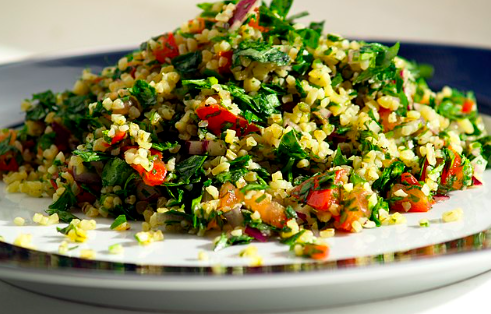
By: Habeeb Salloum/Arab America Contributing Writer
During our farming days on the western Canadian Prairies amid the years of the Depression and the drought, when the rain hardly ever came and the land became an arid desert, we were able to eat our Middle Eastern salads. This is because our hand-watered garden every year overflowed with cabbage, chickpeas, fava beans, cucumbers, lettuce, radishes, tomatoes as well as parsley, mint and other herbs. Hence, salads were an almost every daily fare. As the years moved on, beets, carrots, eggplant, potatoes, and other vegetables were planted and added more of a variety to our garden produce, and thus, to our salads. My father planted and my mother meticulously tended to each and every plant that grew in it, while my siblings and I lugged pails of water from our well, or from the small creek on our homestead, to keep each vegetable or herb alive.
In my pre-adolescent years, summer meant lots and lots of chores. To counter my grumblings of tiring and difficult work, I would think of what Mother was preparing in the kitchen. Nothing was more exciting than knowing that after completing daily chores on our farm, I would be treated to one of her refreshing salads. During these hot and arid summer days, almost each day, she would prepare one or another type of Middle Eastern salad. These salads were never monotonous since mother made so many varieties of them.
It never dawned on me until much later in life that these salads were also some of the most nourishing dishes in the world. In later years, I often prepared these salads for my colleagues and friends taking the opportunity to inform them of their nutritious value.
Over the centuries, the people of the Middle East have refined their salads into a tasty-healthy fare. Indeed, it is no wonder then that these wholesome dishes, with a history going back to early Egyptian and Mesopotamian civilizations, salads such as those with chickpeas and lentils are found today on the health menus of Europe and North America.
The 20th century and today’s 21st century emigrants returning to the Middle East after having spent time in Europe or the Americas contributed to the development of the newer Arab salads with vegetable ingredient additions such as the tasty avocado salad.
However, the traditional salads continued to be the favorites, even when Arabs immigrated. Their passion for the traditional allowed them to introduce their native salads to their non-Arab friends, the best examples being tabouleh, fattoush and even lentil salad that have now become part of North and South American cuisines.
Middle Eastern salads, like the ones my mother prepared on our farm are made nourishing and enriched with a number of other healthy ingredients such as lentils that are high in protein; burghul, a very healthy cooked wheat cereal; pomegranate syrup, a natural sour-sweet food enhancer; sumac, a sour condiment; and tahini, a sesame seed paste.
Chickpea and broad or fava bean salads, which often graced our table during the days of my youth, are almost equally nourishing as burghul and lentils in salads. Delicious when eaten green and tender on their own, both chickpeas and fava beans also serve as excellent salad staples when combined with other ingredients.
All these ingredients and more, such as wild prairie herbs and imported products such as tahini and pomegranate syrup, my mother used in her salads, both ingredients initially not available on the western prairies in the 1920s and 30s. It would not be until later when my parents could order both from Syrian wholesalers in Montreal and New York. However, the main source of ingredients for our salads on the farm during the Depression was our large hand-watered garden – it had to be large – there was a family of 10 to feed. It is no exaggeration to say that thanks to the water from our well, the hard work of every member of our family, and the greens from our garden, all were combined to keep us well-fed and healthy during these lean years. We all took part in the work. The younger ones weeded, those a little older hoed while the eldest ones carried the endless pails of water needed for the plants from the well.
As for ingredients, parsley, usually only used for decorative purposes in western cooking, is truly a king in the preparation of Middle Eastern salads. Such green dishes as tabouleh, safsoof and fattoush, common salads in the eastern Arab countries, all have parsley as one of the main ingredients. Finely chopped and combined with other vegetables and generous amounts of condiments, parsley can turn salads into something truly gourmet.
Some decades back, one of my neighbors, observing a section of my garden flourishing with parsley, asked, “What are you going to do with all this parsley? You have no animals to feed!” I grinned, “We are the animals!” “If you only knew the pleasant taste of this green in salads!” I thought to myself.
For condiments, lemon juice, olive oil and pomegranate syrup are mainly used and the herbs most often included in salads besides parsley are garlic, fresh coriander leaves and mint; while the predominant spices are cayenne, cumin, pepper and sumac. To give these salads even more zest, onions, olives and pine or other nuts can be added.
In the lands of the Middle East and North Africa, the ancient dressing of lemon juice or vinegar and olive oil has stood the test of centuries. Perhaps there is no better indication of how this simple dressing is unmatched than its continued use by the sons and daughters of the Arab immigrants in North America. Even after three or four generations, they continue to prefer it to other well-known dressings such as Caesar, French, Ranch or Thousand Islands.
In North America, with the growing awareness of the health benefits of raw vegetables, these salads on the menu of the Middle Eastern kitchens since the days of Sumer and the Pharaohs, are becoming readily acceptable. Here are some good examples.
Burghul and Walnut Salad- Salatat Burghul wa Jawz
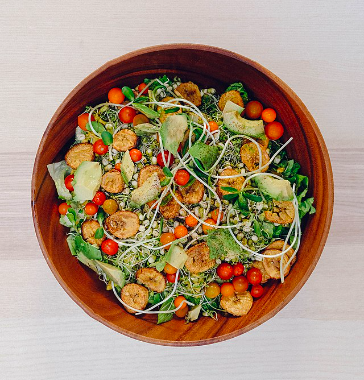
Serves 6 to 8
When mother had some extra walnuts she would make this Aleppo recipe, believed to be of Armenian origin. Considered a salad but with the appearance of a dip, it can be enjoyed with a spoon or with Arab bread.
1 cup fine burghul, soaked for 10 minutes in warm water, then drained by pressing
water out through a fine strainer
1 cup finely ground walnuts
4 tablespoons pine nuts
2 cups finely chopped parsley
1 cup finely chopped green onions
4 tablespoons olive oil
2 tablespoons pomegranate syrup, dissolved in 2 tablespoons hot water
2 tablespoons lemon juice
1 teaspoon salt
1/2 teaspoon black pepper
pinch cayenne
Combine burghul, walnuts, pine nuts, parsley and green onions in a salad bowl and set aside.
Combine remaining ingredients in another small bowl, then pour over contents in the salad bowl. Mix well, then serve.
Burghul and Cabbage Salad – Salatat Burghul wa Malfouf
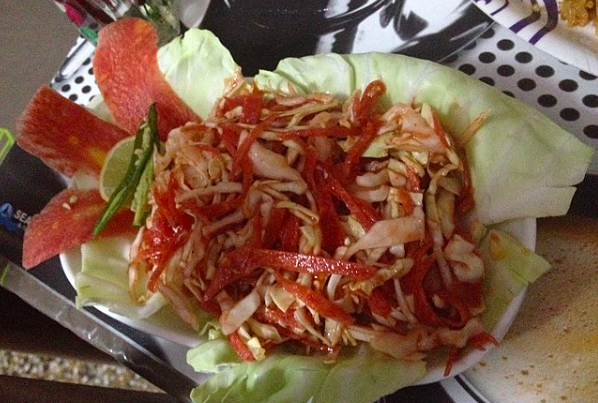
Serves 6 to 8
Introduced by the Armenians, Syrians and other nationals from the Middle East, burghul, a delightful product of wheat, is slowly becoming popular in the Western world.
1/2 cup medium burghul, soaked for 10 minutes in warm water, then drained by pressing water out through a fine strainer
3 cups finely shredded cabbage
2 medium sized tomatoes, diced into 1/2-inch cubes
1/2 cup finely chopped green onions
2 tablespoons finely chopped fresh coriander leaves
3 tablespoons olive oil
3 tablespoons lemon juice
1 teaspoon salt
1/2 teaspoon black pepper
In a salad bowl, combine the burghul and all the vegetables, then set aside.
In a small bowl, mix remaining ingredients, then pour over vegetables and toss just before serving.
Broad Bean Salad – Salatat Fool
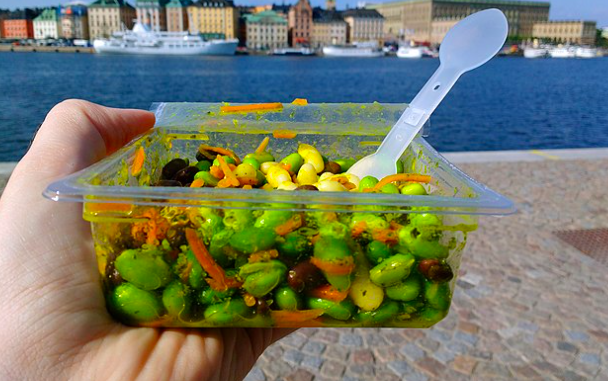
Serves about 4
This salad which can be served as an appetizer or side dish, takes no time to prepare, yet it is very delectable.
1 pound fresh or frozen shelled green broad beans, cooked for 20 minutes after bringing to boil, then drained and cooled
1/2 cup finely chopped parsley
4 tablespoons finely chopped green onions
2 cloves garlic, crushed
3 tablespoons olive oil
2 tablespoons lemon juice
1 tablespoon vinegar
1/2 teaspoon salt
1/2 teaspoon black pepper
Thoroughly combine all ingredients, then place on a serving dish and serve.
Potato and Green Chickpea Salad – Salatat Batata wa Hummus Akhdhar
Serves 4
Absolutely delicious, green chickpeas can be eaten as a simple snack, or roasted and salted in the pod. This salad is seasonal as green chickpeas are only available in the late spring and early summer in Arab grocery outlets.
1-pound potatoes, peeled and diced into 3/4-inch cubes
2 cups green chickpeas, fresh (shelled) or frozen, parboiled for 5 minutes then drained
1 cup finely chopped green onions
1 cup finely chopped red bell pepper
4 tablespoons finely chopped coriander (cilantro)
1 clove garlic, crushed
4 tablespoons olive oil
3 tablespoons vinegar
3/4 teaspoon salt
1/2 teaspoon black pepper
In a saucepan, cover the potatoes with water. Bring to boil then cook over medium heat for 30 minutes or until the cubes are cooked but still whole – not overcooked. Drain and set aside to cool.
Place remaining ingredients in a salad bowl then thoroughly combine. Gently stir in potato cubes then cover and chill for 30 minutes. Toss and serve.
Visit Arab America’s Blog here!


